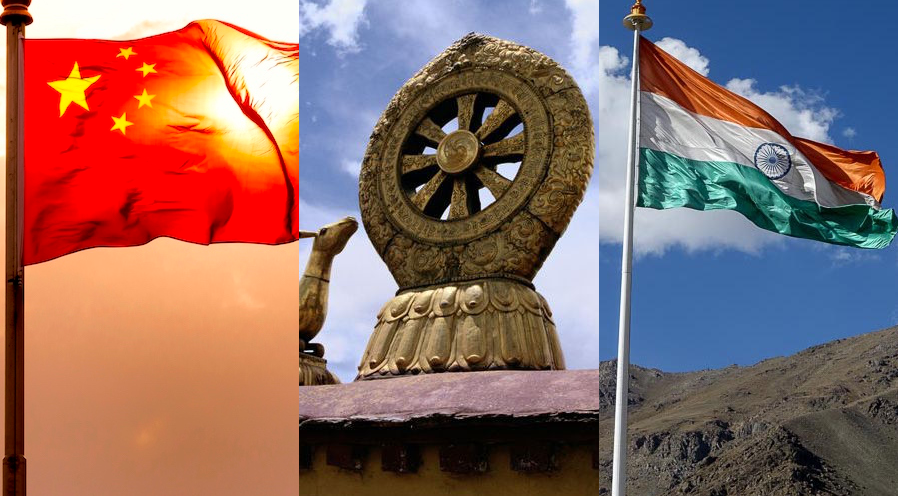At a recent meeting with Buddhistdoor Global, British-born Lokamitra, who has long been involved in Indian (particularly Dalit) affairs since the 1970s, ended his presentation on his institute, Nagaloka Centre in Nagpur, with an observation: “The future of the world will be strongly influenced by relations between India and China. The Buddhist connection can contribute to this relationship.” He was absolutely right: Buddhism is the ancient bond that is becoming more prominent in the two countries’ soft power diplomacy. As such, Buddhist leaders across Asia (and ideally, in the West) should take very seriously the Chinese and Indian orbits that Buddhist institutions move in, for all are interconnected and will be irrevocably shaped by each other.
I see two realistic ways to frame the present context of Sino-Indian relations: “necessarily adversarial, with plenty of collaborative wiggle room,” or “hopefully collaborative, with lots of adversarial caveats.” Either way, one can’t deny that to master this relationship is to shape the destiny of the world’s two most populous countries and cradles of civilisation—and all the regions, countries, and people they touch. The prospect of a stable Asia might well lie in the hands of those who have the burden of attending to this relationship. The entire world stands to benefit from a Sino-Indian relationship where the channels are unblocked and flowing freely and mutually with good ideas, goodwill, and economic and cultural development.
I believe that Buddhism is the oldest, deepest, and most historically attested connection between the two countries. The Buddhist component might not be as “high-stakes” as, say, the question of military capabilities—China and India are, after all, nuclear powers—but as a component of strategic religious diplomacy, it inevitably crosses into what Chris Ogden highlights in his excellent analysis China and India: Asia’s Emergent Great Powers, “strategic cultures and identities.” There is a broad consensus that while India has clear interests and priorities (not to mentioned hardened, excellent diplomats), it lacks a comprehensive grand strategy, in the sense that it does not have “a pre-ordained strategic outlook that is explicitly designed to articulate its various power sources towards a coherent goal.” (Ogden 2017, 52)
Meanwhile, since the end of the Cold War, Chinese central command has maintained four key axioms: avoiding conflict, building comprehensive national power, advancing incrementally, and maintaining stability and sovereignty whilst achieving international pre-eminence and parity. This adaptive but mature strategic thinking rests upon, according to Ogden, increased market access, a slow military buildup backed by economic expansion to reduce vulnerabilities, whilst increasing diplomatic and political leverage, a good neighbour policy via the avoidance of force to settle territorial disputes, and the warding off of all internal and external threats. (Ogden 2017, 50)
These axioms remain unchanged since the launch of the Belt and Road Initiative (BRI) by current president Xi Jinping. It should also be noted that it was Xi and Indian PM Narendra Modi who, shortly after 2010, intensified their countries’ informal policies of Buddhist diplomacy.
I’ve thought long and hard about the comparisons made by Buddhist leaders and observers between the International Buddhist Confederation (IBC), which was founded in 2013, and the World Buddhist Forum (WBF) in China, which had its first symposium in 2006. Because of the aforementioned strategic cultures and identities, China has traditionally had a more unified vision of what it wishes to achieve with its Buddhist organs, including the Buddhist Association of China, the country’s most important Buddhist body. This unity can be felt in Hong Kong as well, where Buddhist organizations and major temples like Po Lin Monastery see Buddhism and China’s future as fundamentally entwined.
To be clear, IBC has clear interests, including encouraging more international Buddhists to see India as the true custodian of the Buddhist faith. I personally wonder how sustainable this is in the long term, since no non-Indian Buddhist sees the Buddha as an avatar of Vishnu—a core rubric in the BJP’s Hindutva ideology. Nevertheless, perception is as important as statistics on the global stage. If India succeeds in persuading the world that it is a great power, then it will be seen as a great power despite certain economic and military disparities between itself and China. Could India convince the world that it is at heart a Buddhist nation?
I certainly think that this is possible, regardless of the low numbers of practicing Buddhists. Numbers are only part of the equation. India has the original holy sites that date back to the life of the Buddha himself. It is recognized by all Buddhists as the birthplace of Buddhism. Buddhism is also growing in importance in India, no less because of a new generation of young and politically savvy Dalit activists who see Dr. Ambedkar’s Buddhist beliefs and hatred of caste and inequality as inseparable.
China could do something similar with its unique brand of “high” Chinese Buddhism, which is theoretically superstition-free, humanistic, and in harmony with traditional Chinese culture. This is embodied in not just the monastics but the “householder elite.” These are lay devotees, often well-travelled and well-educated professionals, who have taken lay ordination and donate to Buddhist temples, run Buddhist charities, and participate in “householder groves,” modern associations that sprang up in large cities like Shanghai during the late Qing and Republican eras. These cosmopolitan, comfortable-in-their-skin Buddhists seem to be a fusion of the householder and that of the all-round “scholar,” which has always been the most admired persona in Chinese literature from ancient times to the present day.
Could both China and India succeed without necessarily having to challenge the other’s claims? Could both views be accommodated, with some negotiation? Indian and Chinese religious and political leaders have often invoked, with varying degrees of success, cross-cultural figures like Xuanzang as statements of shared heritage. I think bolder communication and collaboration than the aforementioned is required. It’s this next deliberation that is the most exciting—and difficult. I wish to reflect on this phase at a later stage, but under no illusions about the complex, dialectic context from which it emerges.

